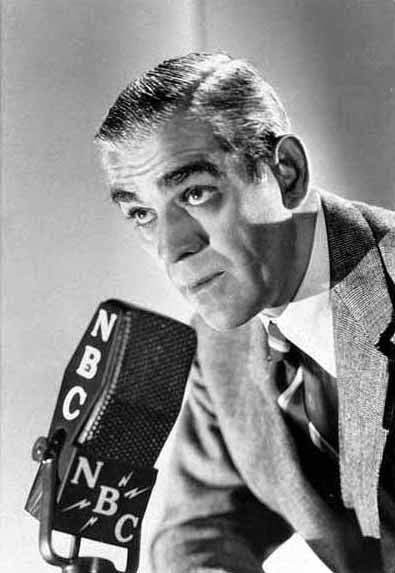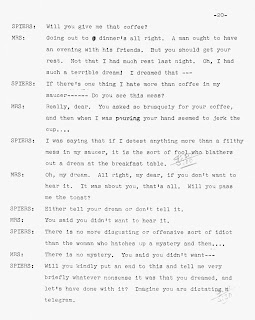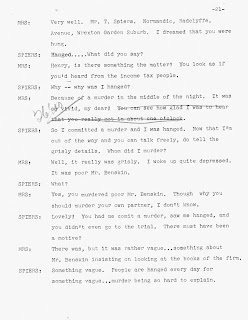 |
| Boris Karloff at the NBC microphone. |
For a quiz program that became a national sensation, with such popularity stunts as The Walking Man contest and the Mrs. Hush contests, it remains a mystery why such a program has yet to receive extensive documentary treatment beyond brief entries in encyclopedias such as John Dunning's On the Air (1998, Oxford University Press). In 1950, the town of Hot Springs, New Mexico, officially changed their name to Truth or Consequences, New Mexico. (For some amusing details about this factoid, visit here: http://torcfiesta.com/past-fiestas/) For a text book example of what I meant by "brief entries," everyone on the internet cites May of 1950 when the town changed its name. But no one has yet to document the exact details of the broadcast pertaining to the contest, including the exact broadcast date of the radio program that launched this stunt... or the numerous towns across the country that participated in the contest and lost because Hot Springs, New Mexico, was the first to do so. (An announcement was made on the tenth anniversary broadcast of Truth or Consequences, the March 25, 1950 radio broadcast and the celebrations inaugurating the change in name were broadcast "live" from Truth or Consequences, New Mexico, on the evening of April 1, 1950.)
Thankfully, progress is underway to correct that oversight. Truth or Consequences will be receiving extensive treatment with a publication in 2015. With luck, additional write-ups about the more colorful contests and surprising discoveries to be posted on my blog throughout 2015.
Truth or Consequences was a zany audience
participation show with contestants from the studio audience taking part in quizzes and stunts presented by the genial master of ceremonies, Ralph Edwards.
The questions were so phrased that the contestants could usually be persuaded that
“they have not told the truth, so they must pay the consequence.” Some of the
“consequences” are paid off in the studio while other contestants were sent out
of the studio and told to report back before the close of the broadcast. These
contestants were accompanied by Ralph Edwards’ assistants, of course. Often, the stunts were planned so that the contestants were at other points, even in other cities, and were tuned into the program from time
to time. Some of the stunts continued through several programs with
certain “assignments” given the contestants by Edwards.
One thing that was undeniable: Contestants received fabulous prizes in the form of both merchandise and cash, and of course, each contestant
received a big red box of DUZ, courtesy of the sponsor, Procter & Gamble. On each broadcast, Ralph Edwards presented one of
the contestants with a $25 U.S. savings bond. Consequences were frequently planned
so as to help a needy person, to cheer and invalid, or to assist in civil service such as the Safety Drive or the
Cancer Fund, for the March of Dimes, or bring awareness of the need to help assist wounded U.S. veterans, etc. During the mid-forties, the program was produced and directed by Al Paschal (Bill
Berch assisted in production). The commercial announcer was Harlow Wilcox.
Musical bridges were supplied by organist Buddy Cole.
Celebrity guests were not uncommon on the program. Often un-billed in advance, celebrity guests have virtually gone undocumented because their names never appeared in advance press releases and radio scripts have been preserved on shelves for years with only a select few having the privilege to browse the archival documents. Try this out for size: Jack Dempsey, Jerry Colonna, Willard Waterman, Sonny Tufts, Guy Lombardo, Celeste Holm, Robert Ripley, Gen. Omar Bradley, Richard Widmark, Cesar Romero, Ann Blyth, Joan Edwards, Anne Baxter, Dan Dailey, Spike Jones, William Bendix, Eddie Bracken, Ned Sparks, the cast of Juvenile Jury, and Frank Sintara were among the celebrity guests on Truth or Consequences, and this is only a random selection of guests from broadcasts dated 1946 to 1948. (The show aired on radio from 1940 to 1956.)
 |
| Action Comics No. 127 |
In 1949, the program made a transition to television. During that same year, radio listeners were invited to participate even if they were not regular listeners. "The Laughing Man" contest involved the cold call solicitation of "The Laughing Man"... with radio listeners glued to the speakers in the hopes that someone would identify the mystery voice and win $2,500 cash. This scenario was spoofed in my favorite scene in Woody Allen's Radio Days (1987). Comedian George Carlin spoofed the series as Truth or Penalties on one of his comedy albums. Superman was the foil for Ralph Edwards' "consequences" in issue 127 of Action Comics. Porky Pig fell victim to the "consequences" Daffy Duck bestowed in The Ducksters (1950). It can be said that the program truly was a national phenomenon.
In respect to the Halloween holiday today, we focus on a recent discovery. Actor Boris Karloff made two appearances on the radio program, paying homage to the spooky cut-throats he portrayed on the silver screen... the first of the two virtually undocumented until now.
Broadcast of October
26, 1946
Broadcast from NBC Hollywood studios. During the broadcast, a telephone call comes in from Dusty Rhodes of Brooklyn, New York, who was presently crossing the country in a cab, paid for by Truth or Consequences. On this program, Edwards tells the radio audience that Dusty and his cab driver were now in New Orleans, Louisiana. However, Dusty is not heard on the program. The telephone rings and Ralph Edwards, speaking from the studio, merely relates the other end of the conversation to the listeners. This was one of the only times a technical connection failed to cooperate during a Truth or Consequences radio broadcast... amazing when you consider the statistics: a third of the radio broadcasts featured some sort of remote broadcast that required challenging hook-ups. The celebrity guest on this program is the well-known actor, Boris Karloff, who took part in one of stunts. A recording is not known to exist of this broadcast and since most of the broadcast was unscripted, Karloff's participation remains unknown... for now.
Broadcast from NBC Hollywood studios. During the broadcast, a telephone call comes in from Dusty Rhodes of Brooklyn, New York, who was presently crossing the country in a cab, paid for by Truth or Consequences. On this program, Edwards tells the radio audience that Dusty and his cab driver were now in New Orleans, Louisiana. However, Dusty is not heard on the program. The telephone rings and Ralph Edwards, speaking from the studio, merely relates the other end of the conversation to the listeners. This was one of the only times a technical connection failed to cooperate during a Truth or Consequences radio broadcast... amazing when you consider the statistics: a third of the radio broadcasts featured some sort of remote broadcast that required challenging hook-ups. The celebrity guest on this program is the well-known actor, Boris Karloff, who took part in one of stunts. A recording is not known to exist of this broadcast and since most of the broadcast was unscripted, Karloff's participation remains unknown... for now.
Broadcast of October
30, 1948
Broadcast from the Milwaukee
Auditorium in Milwaukee, Wisconsin, where the radio cast was making special appearances in connection
with the Milwaukee Retail Grocers’ Association Food Show (cast gave daily shows since Tuesday, October
26, through tonight, October 30, as part of the Food Show entertainment). Ralph Edwards even includes a plug about the Food Show, during the broadcast.
The program featured a cut-in from the “Mystery House,” which was
actually the home of a contestant, Mrs. O’Sullivan, who took part and a Halloween stunt. Special
guests involved in the stunt were Boris Karloff. The woman contestant was
led to think Karloff (in disguise) was her husband. She kissed him many times.
The second of these two radio broadcasts exist in recorded form. But the first one, previously undocumented, can be added to the long list of Boris Karloff radio appearances. No doubt fans of the actor -- and of vintage horror movies -- will find this of interest, but this serves as a reminder that hundreds of other Hollywood celebrities ranging from Celeste Holm, Ann Blyth, Richard Widmark, William Bendix, Frank Sinatra and others are not immune to new discoveries regarding their radio careers... almost seven decades later.



























